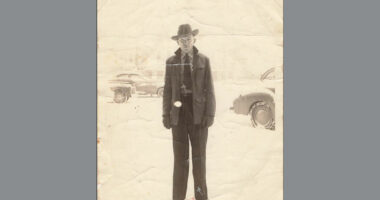Share this @internewscast.com
It would take a quarter of a century to ensure a ruthless killer stayed behind bars, and it was all thanks to a simple staring exchange.
In 1979, Joseph Foy was residing in Ferndale, a suburb of Detroit, Michigan, when his dog’s barking caught his attention and he got up from the couch to peer out the window. As recounted in Unknown Serial Killers of America, he witnessed a man engaged in a physical altercation with a woman in an alley and observed the man making a “slashing motion” as the woman collapsed to the ground.
Foy said he and the “smaller-framed” Black man, who was armed with a knife, locked eyes, leaving the unwitting witness with a lasting impression.
“The eyes I saw that night were just cold,” Foy said. “They were lifeless. They were pure evil.”
At that moment, Foy didn’t realize he had just seen the murder of 36-year-old Helen Dutcher, who was unmarried, at the hands of someone who could be one of America’s most prolific serial killers.
The coed murders in Michigan
According to Investigative Reporter Glenna Whitley, the investigation into Dutcher’s case hit a dead end due to a “complete lack of evidence,” providing no solid leads. Nevertheless, four months later in Ann Arbor—around 45 miles west of Ferndale—police responded to the murder of 17-year-old Shirley Small. She had been walking home alone just before dawn when an unidentified perpetrator attacked her with a knife, delivering multiple wounds, one of which proved to be fatal as it pierced her heart.
Another three months went by when Eastern Michigan University student Glenda Richmond was similarly killed as she reached her residence in the early morning hours. In Richmond’s case, she was stabbed roughly 20 times in the breast with a screwdriver-like instrument.
University of Michigan grad student Rebecca Greer-Huff, 30, was stabbed 54 times in the chest under the same circumstances. Like the other Ann Arbor-area victims, she was only a few feet from her front door.
“They were all single women waking alone, there was no attempt to conceal the body, and no real evidence at the scene,” said retired Captain Paul Bunten of the Ann Arbor Police Department (A.A.P.D.). “That is fairly strange.”
The victims were neither robbed nor sexually assaulted, which made motive difficult to pin down. Still, it became abundantly clear to detectives that they had a serial killer on their hands, and since many of the attacks occurred on Sunday mornings, he quickly earned the moniker “Sunday Morning Slasher.”
Retired Assistant Attorney General Donna Pendergrast, who attended the University of Michigan then, called it “a terrifying year.” College campuses around Michigan were on high alert.
Detectives find suspect
Investigators like Bunten contacted other local and state agencies to learn if comparable attacks had taken place elsewhere. Bunten soon learned of another Kalamazoo-related homicide that fit the unknown killer’s modus operandi. Years earlier, someone murdered a Western Michigan University student in her doorway, leaving an “exact wound pattern” with a screwdriver-like weapon.
Retired A.A.P.D. Sergeant Don Terry was one of the authorities assigned to the Sunday-morning canvasses on campus when, on November 15, 1980, he spotted a Black male in a brown Pontiac Grand Prix stalking a female coed walking home.
The license plate led to Carl “Coral” Eugene Watts, someone reportedly on police’s radar for the Kalamazoo-area attack. He was taken in for questioning, but detectives had nothing to keep him in custody.
“Coral Watts was relaxed, very civil, but he had very hollow eyes,” Bunten told Unknown Serial Killers of America. “He was almost scary to look at.”
Who was Carl “Coral” Watts?
Watts was born in Texas in 1953 and moved with his family to the Detroit area as a child. By all accounts, he had a stable environment around him. But following a severe bout of meningitis at age 8 or 9, relatives reported a sudden personality shift, per board-certified Forensic Psychologist Dr. Harley Stock.
“He started talking about women and the evil spirits and evil eyes,” said Dr. Stock.
Watts’ first known attacks on women started in his early teens, and at age 20, he served a year behind bars for attacking a female pair.
Flash forward years later, when police investigating the college campus murders briefly had Watts in custody. Although there wasn’t enough evidence to hold him, they hoped planting a homing device underneath his Grand Prix could help track his movements.
They found Watts spent his days working for a local trucking business. However, by nightfall, he drove and drove and drove, sometimes adding 300 miles onto his odometer in a single evening.
“Watts was hunting,” Glenna Whitley said. “But, because of the scrutiny he was under, he seemed to have taken a break from this horrible hobby of actually killing women.”
Bunten went to Watts’ residence once the tracker’s battery died, only to find the suspect was not there. Bunten, in turn, contacted Watts’ employer and discovered the suspect quit his job, requesting his final paycheck be sent to Houston.
There, the violence continued.
More murders in Texas
Houston was a hub for homicide in the early 1980s and set the stage for the Sunday, February 7, 1982 murder of college student Elena Semander. According to Semander’s younger brother and sisters, all speaking with Unknown Serial Killers of America, the 20-year-old left home the night before to hang out with friends and failed to return home the following day.
Loved ones said the woman was strangled to death and left inside a dumpster.
“Elena was both artistic and athletic,” her brother, John Semander, said. “So much talent in her.”
Three months passed without any major leads when, on Sunday, May 23, 1982, a man strangled Lori Lister and dragged her unconscious body to her upstairs apartment. There, the assailant ran into Lister’s 18-year-old roommate, Melinda Aguilar, whom he also strangled.
Aguilar let her body go limp and played dead, according to reporter Whitley, before the attacker dragged her into the bedroom.
“The man goes to a closet, and he pulls out some wire hangers, and he binds her hands,” Whitley said. “He gives a little clap and a jump, and Melinda is like, ‘Oh, my God, he is enjoying this.’”
The stranger then left Aguilar and returned to Lister, attempting to drown her in the bathtub. Meanwhile, still bound, Aguilar jumped from a balcony and called for help. A neighbor rescued Lister, who was “about as near death as can be,” from the bathtub, according to retired Houston Assistant District Attorney Jack Frels. Both women survived the vicious attack.
Responding officers apprehended the suspect nearby and identified him as Carl “Coral” Watts.
It transpired that earlier that day, the same man who attacked Aguilar and Lister attacked a female neighbor, Michele Maday, drowning her to death in a bathtub.
Did Coral Watts kill others?
Following Watts’ 1982 arrest, prosecutors charged him with attempted capital murder and burglary with intent to commit murder. However, authorities suspected him of several unsolved homicides and vanishings in the area, including the cases of Suzanne Searles, Linda Tilley, Susan Wolf, Emily Laqua, and Edith Ledet, plus more.
For his cooperation in the unsolved cases, Watts accepted a 60-year prison sentence for the May 23, 1982 attacks and confessed in “tremendous detail” to killing 13 others, according to Cpt. Bunten.
“He told detectives he buried some, he threw a couple in dumpsters, threw one in a swampy area,” Bunten told Unknown Serial Killers of America.
Watts’ motive, according to Whitley, was to “trap their evil spirits.”
Back in Ferndale, Michigan, Joseph Foy, who once locked eyes with the unknown man who murdered Helen Dutcher in 1979, saw Watts on the news and immediately recognized the killer.
“I was calling [authorities] every other day, never heard anything from anybody,” Foy said. “I was livid.”
Foy was under the impression that law enforcement in Michigan decided against pursuing Watts because Watts was expected to spend the rest of his life behind bars in Texas.
Coral Watts up for parole?
Texas prosecutors did not pursue murder charges since they were already locked in the 60-year sentence connected with attempted murder charges, during which time, Watts was granted immunity in the other 13 murders. Due to a technicality with the plea deal, loved ones were shocked to learn in 1992 that Watts was due for automatic release in 2006, meaning he’d only serve 24 years of his 60-year sentence.
Victims’ loved ones, including Semander’s mother, grew furious, organizing calls to action and raising the public’s awareness. In 2002, as Watts’ release date inched closer, news reached Assistant A.G. Donna Pendergrast, who was then the principal homicide attorney in Wayne County, Michigan.
“I received a call from a reporter in Texas who asked me what Michigan was doing about Coral Eugene Watts,” Pendergrast said. “I responded, ‘Who?’”
It was because of the Texas reporter’s information that Pendergrast first learned Watts’ name.
“As I started to do research, my blood went cold, because I realized that Coral Eugene Watts was the boogeyman of my senior year at the University of Michigan,” Pendergrast continued. “We had no idea, as students, that the police had actually zeroed in on a potential assailant and that he had moved on to Texas.”
Investigators in the northern state examined 200 cases in Michigan and Canada that fit Watts’ M.O. Against the clock of his release date, authorities stopped at nothing to find any overlooked detail that could help them pin Watts with murder charges. They hoped a public appeal might do the trick.
In January 2004, eyewitness Joseph Foy spotted a photo of Watts on the news and contacted Pendergast about Helen Dutcher’s 1979 murder. It was enough for Watts to face murder charges in Michigan, and, thanks to Pendergrast’s petitions, a judge allowed her to introduce the Texas murders he’d confessed to.
“Once I sat in the witness stand, I looked right at Watts, and he looked at me,” Foy said. “It was just like that alley that night.”
In November 2004, a jury found Watts guilty of the first-degree premeditated murder of Helen Dutcher. The conviction amounted to a life sentence.
Pendergrast said authorities were unsure how many victims Watts killed, but she believed they were “not even close.” Dr. Stock said estimates have gone beyond 100 women, which would make Watts “the most prolific serial killer in the United States.”
“Watts did say one thing eventually,” said Stock. “’There aren’t enough fingers and toes in this room for the number of women I’ve killed.’ This was chilling.”
Watts died behind bars in 2007.
Learn more by watching Unknown Serial Killers of America on Oxygen.










